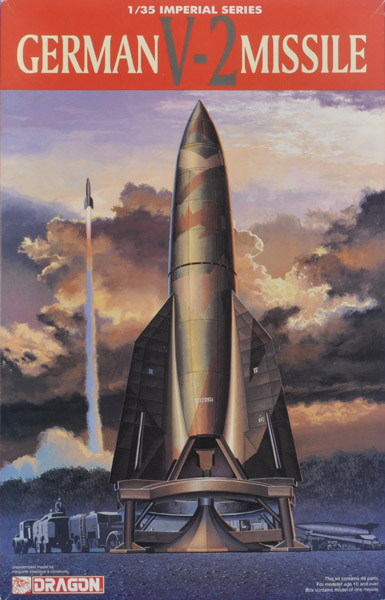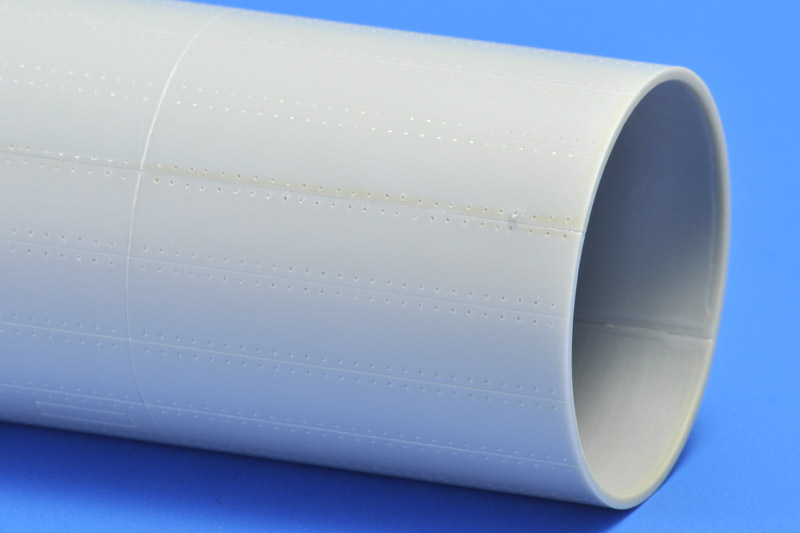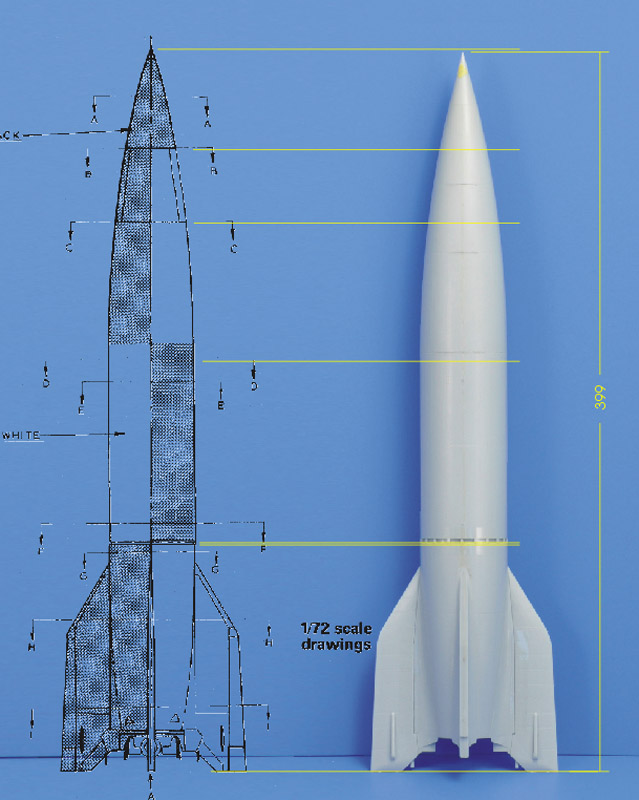Dragon 1/35 V2 (Aggregat-4)

Maybe it was boredom that lead me to buy Dragon's 1/35 V-2 missile. It did not fit in my prefered scale of 1/72, and I had no real interest in the subject. I started building it mainly to apply an interesting splinter camouflage.
Many years later I worked on it some more, and made some discoveries that made me stop this project, as explained below. Happily the model found a new owner.
|
Kit description and accuracy
First, I need to mention that I did not look at the accuracy when I started working on the model. And as so often happened before, I found serious problems only halfway the build.
The kit's surface detailing looked awkward to me: the whole body except the nose section has long rectangular panels, that have rivet detail along the long sides of each panel, but none on the short ends, or halfway the panel. The real thing indeed had long narrow sheet metal panels, but no rivets are visible - reportedly it was spot welded. In some museum photos I see overlapping panels, instead of butt-jointed panels, which was not uncommon for the era. But the main thing is that the contrast between the fully riveted main body and the 'bare' nose creates a strange contrast.
Apart from the surface detailing problem, the real thing was built very rough, with lots of buckling of the thin sheet metal. The model does not represent that at all, it's a perfectly smooth shape. I do understand the difficulties of creating such a wrinkled shape, but the model simply does not have the character of the real thing. Changing that yourself would require building a complete new model.
The nose section is where I started noting serious shape problems. The extreme nose is the warhead, where the model has 2 or 4 longitudinal engravings, depending on whether you rescribe the glue joints. It looked excessively long on the model, and slightly too straight. The next section is for the instrumentation, and has four hatches. The kit's hatches are quite underdetailed, and the instrumentation section appears to be positioned way too far down from the nose. It was then when I started looking for V2 drawings to compare the shape. I did not find a definitive one, but had to cobble together the evidence. It is presented below.
Regarding the launch platform in the kit, I seem to remember reading that it is not the type used operationally. Another version of this model has a different launch platform.
Construction
The rivets on the edges of the center body halves suffer badly from the impossibility of molding engraved rivets that are perpendicular to the mold ejection direction. After gluing the halves together and sanding, hardly anything remained. A very laborious task was ahead, and I almost gave up on the model. In the end, the riveting was executed with a needle and an 0.5 mm drill.
And when I had finished the job, I learned that the darn thing was spot-welded, not riveted. Hmm.. Not sure what to do now. Another problem is that only the longitudinal rows of 'rivets' are done, not the circumferential ones. I made a drawing in CorelDraw to study what solution looked natural, and printed that to serve as a template to add the circumferential rivet holes (not shown here).
| 
|

| I combined the center fuselage with the top fuselage parts, but left off the extreme nose part for the time being. The top fuselage has no 'rivets' at all, quite a strange contrast to the center fuselage.
The lower fuselage was assembled from two main parts. The notched ring (part A4) that goes between the bottom and center fuselage was slighty undersized. I cut it open and inserted a 1.5 mm piece of plastic card. You can see it if you look closely.
|
Drawings versus Dragon's model
An American post-war drawing with section lengths was useful, although it wasn't drawn accurately. The quoted sections lengths did not match the drawing, and the body diameter is too large. The sum of the section lengths gives 46'11" = 14.30 m. The later is commonly found in US references, but German drawing shows 14.03 m! That diffence is almost a foot, which cannot be neglected. But I had no way to solve it, so I scaled the drawing to 408.6 mm instead of 400.9 mm.
Nevertheless, the drawing did give a clear picture of the section lengths, which confirmed the shape errors that I thought I saw. I made a telelens photo of the model, and combined it with the drawing in CorelDraw. Immediately it become clear that the kit's sections did not match: the fuel tank sections is 20 mm short, the instrumentation section has the correct length but is too far down, and the warhead is far too long. The model is 399 mm long, almost spot on with the German number. I measured a diameter of 48.2 mm, one millimeter over the official number that scales to 47.2 mm.
| 
|

| My modeling friend Eric Verschuur found another good drawing in an old Scale Models issue. The overall shape and height of the drawing and model agree pretty well. But again, the sections do not agree at all: the model's warhead is too long, and the instrumentation section is too far down.
At this point I gave up on the model, because I really did not fancy doing a ton of rescribing of the model. I sold it on Dutch auction site Marktplaats to a modeler less picky than me.
|
Modeling links
Return to models page




